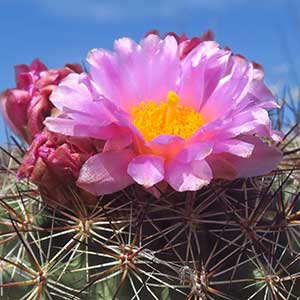Pediocactus nigrispinus
Pediocactus simpsonii
black-spine snowball cactus, Columbia Plateau cactus, dark-spine ball cactus, snowball cactus
mountain ball cactus, mountain cactus, Simpon's hedgehog cactus, Simpson's footcactus, Simpson's hedgehog cactus
depressed-ovoid to elongate-ovoid, 5–30 × 5–15 cm;
areoles oval, villous.
depressed-ovoid to ovoid or globose, 2.5–15(–25) × 2.5–15 cm;
areoles circular to oval, villous.
smooth, hard and rigid, distinguishable as radial and central;
radial spines 10–30 per areole, spreading at right angles to tubercles, nearly straight, white to dull reddish brown, 8–20 mm;
central spines 6–12 per areole, widely spreading or nearly erect, reddish brown to nearly black, rigid, straight or slightly curved, base yellow or cream, 15–35 mm, less than 1 mm diam. at base.
smooth, relatively hard, distinguishable as radial and central;
radial spines 15–35 per areole, widely spreading, white, slender, 3–13 mm;
central spines 4–11 per areole, reddish brown (rarely black) with basal 1/2 cream or yellow, rigid, straight or slightly curved, 5–21 × 0.3 mm.
1–3.5 × 2.5–5 cm;
scales and outer tepals of flower tube minutely toothed, laciniate, or entire and undulate;
outer tepals with greenish brown midstripes, oblong-cuneate, 12–25 × 4.5–9 mm;
inner tepals white, pink, magenta, yellow, or yellow-green, 19–27 × 5–10 mm.
1.2–3 × 1–2.5 cm;
scales and outer tepals minutely toothed and laciniate or entire and often undulate;
outer tepals with greenish brown midstripes, oblong-cuneate, 9–20 × 3–5(–6) mm;
inner tepals white, pink, magenta, yellow, or yellow-green, 12–25 × 4.5–6(–9) mm.
green tinged with red, drying reddish brown, short cylindric, 6–11 × 5–10 mm.
green tinged with red, drying reddish brown, short cylindric, 6–11 × 5–10 mm.
gray to black, 2–3 × 1.5–2 mm, papillate but not rugose.
gray to black, 2–3 × 1.5–2 mm, papillate but not rugose.
Pediocactus nigrispinus
Pediocactus simpsonii
No known morphologic character supports the taxonomic recognition of infraspecific taxa within Pediocactus nigrispinus. Characteristics used to distinguish the three described subspecies almost completely overlap. Pediocactus nigrispinus has been referred to P. simpsonii var. robustior (J. M. Coulter) L. D. Benson, which remains well within the range of variation for P. simpsonii. An unpublished study by J. M. Porter et al. of noncoding chloroplast DNA sequences shows P. simpsonii is less closely related to P. nigripsinus than to P. knowltonii, P. winkleri, and P. despainii.
(Discussion copyrighted by Flora of North America; reprinted with permission.)
Pediocactus simpsonii is an exceedingly variable species. The segregation of the many forms, varieties, and subspecies on the basis of morphology, however, is difficult to support, given the continuous range of variation in stem size and flower color over its geographic range. The species has the widest distribution of any Pediocactus, and is found at the highest elevation.
(Discussion copyrighted by Flora of North America; reprinted with permission.)


